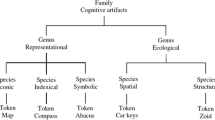Abstract
Two approaches to externally distributed individual cognition are contrasted in the paper. The first begins with making a distinction between minds and artifacts, both considered as structural components of larger-scale cognitive systems, while the second focuses on the dynamic coordination of internal and external resources within the context of human interaction with the world. Conceptual limitations of the first approach are discussed. The notion of functional organs is introduced and applied for identifying the types of abilities associated with efficient integration of artifacts into the structure of human activity.
Similar content being viewed by others
References
Bateson, G. (1972). Steps to an Ecology of Mind. Ballantine Books. N.Y.
Blumenthal, B. (1995). Industrial Design and Activity Theory: A New Direction for Designing Computer-Based Artifacts. In Blumenthal, Gornostaev, and Unger (eds) Human-Computer Interaction. 5th International Conference, EWHCI ’95, Moscow, Russia, July 3–7, 1995. Selected Papers. Lecture Notes In Computer Science. V. 1015. Springer.
Bødker, S. (1991). Through the Interface: A Human Activity Approach to User Interface Design. Lawrence Erlbaum. Hillsdale, NJ.
Cole, M. and Engeström, Y. (1993). A Cultural-Historical Approach to Distributed Cognition. In Salomon (ed) Distributed Cognitions: Psychological and Educational Considerations. Cambridge University Press.
Engelbart, D. (1963). A Conceptual Framework for the Augmentation of Man’s Intellect. In Howerton (ed) Vistas In Information Handling. 1. Spartan Books.
Engelbart, D. C. (1982). Towards High-Performance Knowledge Workers. In OAC-82 Digest (Proceedings of the 1982 AFIPS Office Automation Conference, San Francisco, CA.)
Hutchins, E. (1995). Cognition in the Wild. The MIT Press. Cambridge, Mass.
James, W. (1890). The Principles of Psychology. Henry Holt and Company. N.Y.
Kaptelinin, V. (1996a). Computer-Mediated Activity: Functional Organs in Social and Developmental Contexts. In Nardi (ed) Context and Consciousness: Activity Theory and Human-Computer Interaction. The MIT Press.
Kaptelinin, V. (1996b). Creating Virtual Workplaces: An Empirical Study of Macintosh Users. In Proceedings of the ACM SIGCPR/SIGMIS’96 Conference, April 11–13, 1996, Denver, CO.
Kaptelinin, V., Kuutti, K., and Bannon, L. (1995). Activity Theory: Basic Concepts and Applications. In Blumenthal, Gornostaev, and Unger (eds) Human-Computer Interaction. 5th International Conference, EWHCI ’95, Moscow, Russia, July 3–7, 1995. Selected Papers. Lecture Notes In Computer Science. V. 1015. Springer.
Kidd, A. (1994). The Marks Are on the Knowledge Worker. In Proceedings of the CHI ’94 Conference on Human Factors in Computing Systems, April 24–28, 1994, Boston.
Kozma, R. B. (1992). Constructing Knowledge With Learning Tools. In Kommers, Jonassen, and Mayes (eds) Cognitive Tools For Learning. Springer.
Leontiev, A. N. (1978). Activity, Consciousness, and Personality. Prentice Hall. Englewood Cliffs, NJ.
Lewin, K. (1952). Field Theory and Social Science. Selected Theoretical Papers. Tavistock. London.
Nardi, B. (1996). Studying Context: A Comparison of Activity Theory, Situated Action Models, and Distributed Cognition. In Nardi (ed) Context and Consciousness: Activity Theory and Human-Computer Interaction. The MIT Press.
Norman, D. (1988). The Psychology of Everyday Things. Basic Books. NY.
Norman, D. (1991). Cognitive Artifacts. In Carroll (ed) Designing Interaction: Psychology at the Human-Computer Interface. Cambridge University Press.
Norman, D. (1993). Things That Make Us Smart: Defending Human Attributes in the Age of the Machine. Addison-Wesley. Reading, Mass.
Pea, R. D. (1993). Practices of Distributed Intelligence and Design for Education. In Salomon (ed) Distributed Cognitions: Psychological and Educational Considerations. Cambridge University Press.
Perkins, D. N. (1993). Person-Plus: A Distributed View of Thinking and Learning. In Salomon (ed) Distributed Cognitions: Psychological and Educational Considerations. Cambridge University Press.
Salomon, G. (1993a). Editor’s Introduction. In Salomon (ed) Distributed Cognitions: Psychological and Educational Considerations. Cambridge University Press.
Salomon, G. (1993b). No Distribution Without Individual’s Cognition: A Dynamic Interactional View. In Salomon (ed) Distributed Cognitions: Psychological and Educational Considerations. Cambridge University Press.
Vygotsky, L. S. (1978). Mind and Society. Harvard University Press, Cambridge.
Wertheimer, M. (1961). Productive Thinking. Tavistock. London.
Zinchenko, V. (1996). Developing Activity Theory: The Zone of Proximal Development and Beyond. In Nardi (ed) Context and Consciousness: Activity Theory and Human-Computer Interaction. The MIT Press.
Author information
Authors and Affiliations
Corresponding author
Rights and permissions
About this article
Cite this article
Kaptelinin, V. Distribution of cognition between minds and artifacts: Augmentation of mediation?. AI & Soc 10, 15–25 (1996). https://doi.org/10.1007/BF02716751
Issue Date:
DOI: https://doi.org/10.1007/BF02716751




